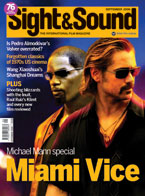Primary navigation


Please view our back issues page for more information about obtaining previous months issues, dating back to 1995.
 Edinburgh 2006: Giant Steps
Edinburgh 2006: Giant StepsUS cinema in the early 1970s is a story of film-makers who refused to sell out. David Thomson celebrates a programme of their work at the Edinburgh International Film Festival.
 Edinburgh 2006: Ten Sight & Sound Edinburgh Selections
Edinburgh 2006: Ten Sight & Sound Edinburgh SelectionsS&S selects the best of the rest.
Michael Mann's Miami Vice TV cop show was a high-stakes morality play with pulp beauty, stylistic delirium and an MTV vibe. How well has it translated into a feature film, asks Graham Fuller. Plus Timothy Shary explores the flawed masculinity at the core of the director's 1981 debut Thief.
China's economic boom has transformed the country's cities and the lives of its citizens, yet little of that reality makes its way to western screens. Michael Berry shows us what lies beyond the martial-arts costume dramas. Plus Shanghai Dreams director Wang Xiaoshuai tells Roger Clarke about the new liberalisation.
Fin-de-siècle Vienna was remembered by classic Hollywood film-makers in exile as a city of culture and romance with a heart of darkness. Geoffrey Macnab asks if films from Max Ophuls' La Ronde to Raúl Ruiz's new portrait of the painter Klimt capture its essence.
With Atanarjuat The Fast Runner Zacharias Kunuk and Norman Cohn gave visual form to an Inuit myth that had never been written down. Their new film The Journals of Knud Rasmussen recharts the first encounter with Danish explorers from an Inuit point of view. S.F. Said spent ten weeks in the Arctic searching for authenticity
 DVD review: Electric Shadows
DVD review: Electric ShadowsTim Lucas enjoys an affectionate tribute to the past glories of Chinese cinema
 Film of the Month: Volver
Film of the Month: VolverCritics - including Sight & Sound's - and fans alike seem bewitched by the so-called Almodóvar effect, but, argues Peter Matthews, closer scrutiny of some of the Spaniard's recent films suggests a slick recycling of tired themes